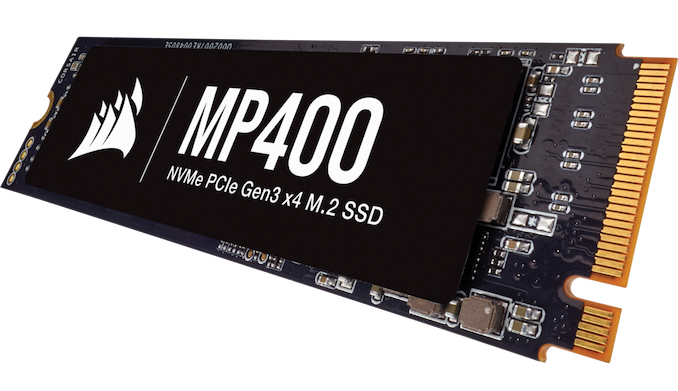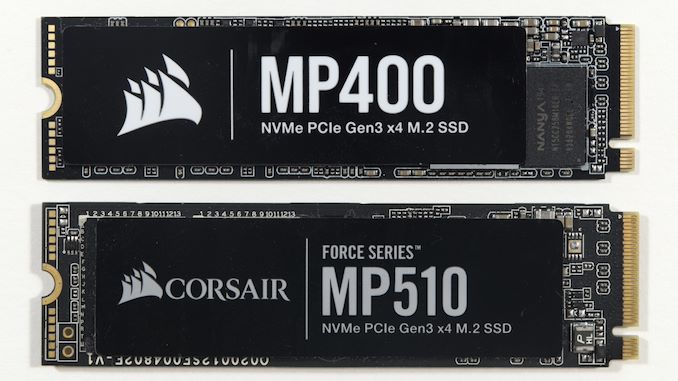The Corsair MP400 1TB QLC NVMe SSD: A Quick Review
by Billy Tallis on December 11, 2020 2:00 PM EST
Following up from our recent look at 8TB QLC SSDs, today we're taking a look at the 1TB Corsair MP400. This is a QLC NVMe SSD using the Phison E12 controller, which puts it a step up from earlier QLC SSDs that used four-channel Silicon Motion controllers. Unlike last week's review of 8TB SSDs, this time we're dealing with a much more affordable capacity of 1TB. At 8TB, many of the downsides of QLC NAND can be overcome by the sheer volume of flash memory, but this 1TB drive falls toward the low end of the QLC SSD capacity range and faces real competition from entry-level drives using TLC NAND.
Corsair MP400
The MP400 is Corsair's answer to Sabrent's Rocket Q and other similar SSDs that have adopted the combination of the Phison E12S controller and QLC NAND. Compared to the Sabrent Rocket Q, Corsair's specifications for the MP400 are a bit more optimistic on performance and a bit lower on the write endurance rating, but we expect the real-world differences between these drives at the same capacity to be insignificant given the near-identical hardware.

Corsair MP400 1TB (QLC) and the Corsair Force MP510 (TLC)
Sabrent's Rocket Q product line covers capacities from 500GB to 8TB. Corsair drops the 500GB option, which is very reasonable: we consider 1TB to be the bare minimum for a QLC drive to make sense. That's especially true of these drives that use an 8-channel Phison E12S controller, half of which goes unused on a 500GB QLC model. Mushkin's recently announced ALPHA series goes even further and will only offer 4TB and 8TB options.
| Corsair MP400 Specifications | |||||
| Capacity | 1 TB | 2 TB | 4 TB | 8 TB | |
| Form Factor | M.2 2280 PCIe 3 x4 | ||||
| Controller | Phison E12S | ||||
| NAND Flash | Micron 1Tbit 96L 3D QLC | ||||
| Sequential Read (MB/s) | 3480 | ||||
| Sequential Write (MB/s) | 1880 | 3000 | |||
| Random Read IOPS (4kB) | 190k | 380k | 610k | ||
| Random Write IOPS (4kB) | 470k | 560k | 710k | ||
| Power Consumption | 4.0 W | 5.5 W | 6.5 W | 6.5 W | |
| Warranty | 5 years | ||||
| Write Endurance | 200 TB 0.1 DWPD |
400 TB 0.1 DWPD |
800 TB 0.1 DWPD |
1600 TB 0.1 DWPD |
|
| Current Retail Prices | $114.99 (11¢/GB) |
$244.99 (12¢/GB) |
$662.00 (17¢/GB) |
$1498.00 (19¢/GB) |
|
The 1TB capacity point is currently the volume spot in the consumer SSD market for QLC, with the most competition and the best prices on a per-GB basis. QLC SSDs have made multi-TB SSDs more affordable, but 2TB and larger drives still tend to carry a premium. In the entry-level NVMe market segment, there's overlap at 1TB between DRAMless TLC designs and QLC with DRAM designs, two markedly different strategies for cutting costs. There are thankfully only a handful of DRAMless QLC NVMe drives that combine both weaknesses. There are also a few relatively budget-oriented TLC SSDs with DRAM that hit low price points using cheaper 4-channel controllers.

Corsair MP400 1TB (QLC, Top) and the Corsair Force MP510 (TLC, Bottom)
Each of these approaches to an entry-level NVMe SSD (QLC+DRAM vs TLC without DRAM) comes with its own typical weaknesses, and some advantages. DRAMless SSDs will suffer under workloads with heavy random IO, but where they do offer decent performance they tend to have very good power efficiency - not having to power any external DRAM chips helps. QLC SSDs suffer most during sustained writes, and are very heavily reliant on their SLC caches. Smaller drives have smaller SLC caches, so it will be much easier to overflow that write cache on this 1TB MP400 than on the larger variants. Most QLC and TLC drives tend to use SLC caches, but QLC drives also tend to use the largest SLC cache sizes possible, which exacerbates the performance problems once the cache is full - there's little or no empty flash left that could be written to directly as QLC, and until the drive can catch a break, further writes will require compacting data from the SLC cache into QLC blocks to free up space.
Most drives using 4-channel controllers have notably limited throughput. SK hynix was first to market with a 4-channel drive that could saturate PCIe 3 x4 (with TLC NAND), and that Gold P31 is priced more like a high-end drive. Silicon Motion has introduced a 4-channel Gen4 controller that is also more than fast enough for a Gen3 x4 interface, but it also is not yet cheap enough for entry-level drives. So for now, the 8-channel Phison E12 controller is the best option for high-capacity QLC SSDs to improve performance.
This review has two main points of comparison for our 1TB Corsair MP400 sample: the 8TB Sabrent Rocket Q we recently reviewed is the most similar, and lets us see how this Phison E12+QLC design scales down to smaller capacities. We also have results for several other 1TB entry-level SSDs, including DRAMless TLC models from Mushkin and Toshiba/Kioxia, and earlier QLC NVMe drives from Intel and Crucial. Unfortunately, we were unable to secure the Western Digital WD Blue SN550 in time for this review; it generally seems to be the best DRAMless TLC drive on the market, and would offer the toughest competition against QLC designs at this 1TB capacity point.
Read on for more analysis.
| AnandTech 2018 Consumer SSD Testbed | |
| CPU | Intel Xeon E3 1240 v5 |
| Motherboard | ASRock Fatal1ty E3V5 Performance Gaming/OC |
| Chipset | Intel C232 |
| Memory | 4x 8GB G.SKILL Ripjaws DDR4-2400 CL15 |
| Graphics | AMD Radeon HD 5450, 1920x1200@60Hz |
| Software | Windows 10 x64, version 1709 |
| Linux kernel version 4.14, fio version 3.6 | |
| Spectre/Meltdown microcode and OS patches current as of May 2018 | |
- Thanks to Intel for the Xeon E3 1240 v5 CPU
- Thanks to ASRock for the E3V5 Performance Gaming/OC
- Thanks to G.SKILL for the Ripjaws DDR4-2400 RAM
- Thanks to Corsair for the RM750 power supply, Carbide 200R case, and Hydro H60 CPU cooler
- Thanks to Quarch for the HD Programmable Power Module and accessories
- Thanks to StarTech for providing a RK2236BKF 22U rack cabinet.














75 Comments
View All Comments
GeoffreyA - Tuesday, December 15, 2020 - link
My mistake! Made a blunder here. LBAs written (241) are the host/OS writes. Well, I can't seem to find SMART value 249 (NAND writes). Cunning work by Samsung, not exposing that value.Is where "Wear Leveling Count" the one to use with the P/E cycles? Mine is at 5. Calculating 5 / 2,000 (for TLC, roughly) doesn't seem to yield a sensible value, against the drive's TBW and the OS writes. I'm stumped.
GeoffreyA - Tuesday, December 15, 2020 - link
Another AT article helped here. Seems to be that 1 P/E cycle equals the capacity of the drive in NAND writes, roughly; and the raw Wear Levelling Count equates to used P/E cycles.Roughly: Raw WLC x drive capacity == NAND writes
For me, I get: 5 x 500 == 2,500 GB
I'm scratching my head though because that yields a write amplification that seems erroneously small, only 1.09x (2,500 nand / 2,300 host).
https://www.anandtech.com/show/8239/update-on-sams...
MDD1963 - Sunday, December 13, 2020 - link
'only 200 TBW'...based on my 10 TB per year as a 4 hours per day 'ordinary desktop user/surfer', the drive would be ending it's life in writes at merely 20 years for me... Best to shop elsewhere! :)nucc1 - Wednesday, December 16, 2020 - link
I just looked at the SMART data for my solid state devices, and I'm averaging 0.03 TB per day. over 660 (total power on) days on my oldest SSD. According to Aida64, the drive still has about 95% remaining lifetime. It's a Samsung Sata 850 EVO 500GB.I like to think I'm not an average user, because this machine is running boinc always, and I use these SSDs for running virtual machines whose lifetime is typically less than 90 days each and, I'm also hosting a media server on this machine for in-home streaming.
I used to worry about longevity too, thinking myself to be a heavy user, but the numbers have not borne this suspicion out.
My current OS boot drive, with bitlocker ON is a sabrent 1TB nvme device, currently averaging 0.022 TB written per day over it's 160 day lifetime, and 99% lifetime remaining. If endurance is the only thing that kills these drives, I have many years of worry-free operation left in all these budget, consumer drives packed into my system.
shabby - Friday, December 11, 2020 - link
Go home corsair, you're drunk...You guys should stop accepting these overpriced qlc junk drives for review.
boozed - Friday, December 11, 2020 - link
Why, so we'll never know how they perform?shabby - Friday, December 11, 2020 - link
We don't need to know how they perform, just their price, we know they all perform like shit.Maverick009 - Friday, December 11, 2020 - link
Not exactly true. QLC drives are still a step up from mechanical drives in certain case scenarios, and depending on the pairing of the controller, can even come close or on par with some of their counterparts.Rather have choice with competition rather then your narrow sight of vision as not every drive is built the same.
Gigaplex - Wednesday, December 16, 2020 - link
And then when a QLC drive comes out that's actually good, we'd never know...kpb321 - Friday, December 11, 2020 - link
Price is always where the QLC drives have failed for me. As the article notes it is usually pretty easy to find an 8 channel with dram drive for minimal price premium over one of the QLC drives. Not to mention the other low cost variants with 4 channels and/or dramless that are almost always available at similar price points and while they might have some compromises also compared the better drives they are usually smaller compromises and easier to accept. I just don't see the QLC drive providing the value if there are TLC alternatives available.